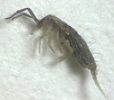
Problems with Springtails are entirely controllable under professional care. Our treatment goal is to stop a problem at its source so it doesn’t keep coming back. Using state-of-the art equipment and methods, our licensed exterminators will inspect your home’s environment and construction to identify the problem and determine the best course of action. Contact us today!
Springtails are harmless to man and animals but they can cause problems in large numbers to plants especially in greenhouses and young plants. They feed on algae, decomposing vegetable matter, bacteria and fungi. When Springtails occur in large numbers and search for new suitable habitats, they can enter homes and invade kitchens and bathrooms.
Springtails are occasionally misidentified as fleas because they can occur in the home and jump. However, they are round and soft bodied instead of dark brown and flattened. They also have normal hind legs, whereas fleas have hind legs modified for jumping.

Springtails are tiny at only about 1 to 2 mm long but can move rapidly because of a springing mechanism in their abdomen that functions like a catapult and can launch them forward in less than 2/10ths of a second. This allows them to jump 3 or 4 inches. They are wingless insects and their coloring varies, depending on species, they have antennae and 3 pairs of legs.
There are over 700 species of Springtails in North America and scientist have classified them in a class called Collembola rather than insecta, because they have unique features normally not found in insects such as internal mouth parts.
Springtails invade structures in search of moisture when their usual habitat becomes dry. They are attracted to light and are so small that they can enter houses through cracks and crevices around doors, utility pipes, window screens, etc. They can also be brought indoors in the soil of potted plants. Indoors, they are most often found in high-moisture areas such as bathrooms, kitchens, crawlspaces and basements. Moldy furniture is also able to support large infestations.
Their usual outdoor habitats include mulch, leaf litter, other decaying organic matter, firewood, logs and landscape timbers. Normally soil contains sufficient moisture and food for springtails to survive. Their food includes decaying vegetation, fungi, bacteria, pollen, algae, lichens and insect feces.
The feeding activities of springtails enrich the soil by breaking down these forms of organic matter and releasing the nutrients they contain. Because of these activities, springtails are considered to be a good indicator of soil health
Homeowners who see these tiny, grayish insects in and around houseplant containers are often concerned that they are likely to harm their plants; however, this is not the case. Springtail activity is an indication of healthy, moist, organically rich soil. If the Springtails remain confined to the soil of houseplants, it is not necessary to initiate control measures unless there are so many that they cause a nuisance.
When springtails are found in and around bathtubs and showers, these areas must be cleaned thoroughly and kept dry to correct the problem. For a temporary solution to indoor springtail problems, you can use a household aerosol spray. However, the problem will recur if the sources of moisture and organic matter are not removed.